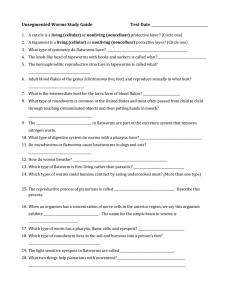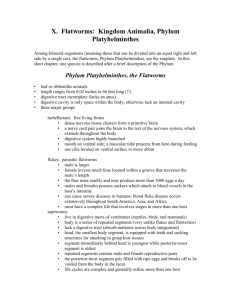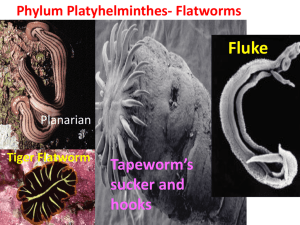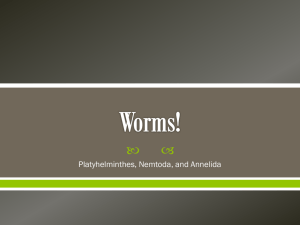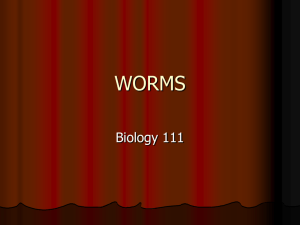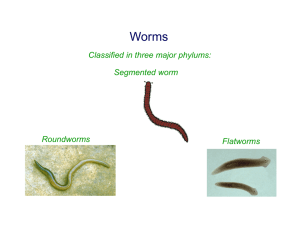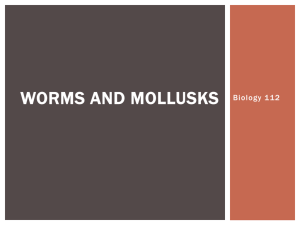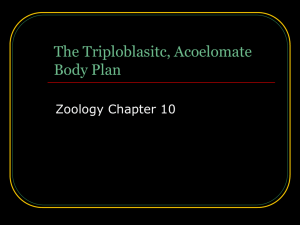File - Ms. Trimble's Website
advertisement
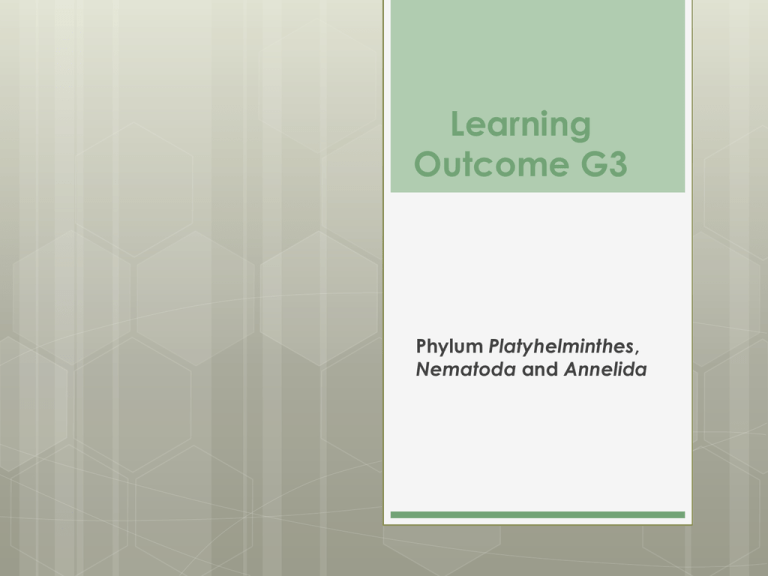
Learning Outcome G3 Phylum Platyhelminthes, Nematoda and Annelida Learning Outcome G3 Analyze the increasing complexity of the Phylum Platyhelminthes, the Phylum Nematoda and the Phylum Annelida Student Achievement Indicators Students who have fully met this learning outcome will be able to: Examine members of the Phylum Platyhelminthes and describe their unifying characteristics. Describe how platyhelminthes carry out their life functions Examine members of the phylum Nematoda and describe their unifying characteristics. Describe how nematodes carry out their life functions Examine members of the Phylum Annelida and describe their unifying characteristics Describe how annelids carry out their life functions Describe the physical chanes that were necessary for flatworms and roundworms to become parasitic Evaluate the characteristics of a successful parasite Describe human disorders that are caused by non-segmented worms. Compare platyhelminthes, nematodes and annelids with respect to evolutionary changes Describe the ecological role of platyhelminthes, nematodes and annelids The Flatworms Classification Kingdom Animalia Phylum Platyhelminthes Characteristics Exhibit bilateral symmetry Have a mesoderm Have a basic primitive system for digestion and excretion Most primitive organism to show cephalization Can be free-living or parasitic Parasitic flatworms live on or on the body of a host from which they obtain their nutrients Do not have a coelom Adaptations for a Free-Living Lifestyle Live in moist or submerged habitats in both marine and fresh water. Most are small, less than 1 cm in length but can be much larger There are very large terrestrial forms that may reach up to 60 cm in length Example – of a free-living flatworm is planaria Digestive System Like cnidarians, free-living flatworms have a “blind” digestive system, with the mouth as the only entrance or exit. Parasitic flatworms do not have a digestive system because the obtain pre-digested nutrients from their host Excretory System Very primitive Do have a rudimentary excretory system consisting of a network of fine tubules running though the body and opening to the outside via tiny pores Nervous System Very primitive Has a collection of nerve tissue that resembles a primitive brain. Two nerve chords, each made up of tiny nerve cells, arise for the “brain “ and run along the ventral side of the body towards the tail The nervous system appears to coordinate body movement and receives input from simple sensory cells, allowing more complex movement than previous groups. Reproductive System Simple A reproductive system is present only during the breeding season and degenerates at other times of the year Fertilized eggs are released in tiny capsules that contain a small number of eggs and thousands of nutritive yolk cells. These capsules attach to objects in the water, and within two or three weeks these eggs hatch into juveniles. Juvenile flatworms resemble adult flatworms Some planarians can reproduce asexually by fragmentation Adaptations for a Parasitic Lifestyle May look very different from free-living forms Can be found both on the inside and outside of an animal’s body Parasites living within a host, can not grow very large, because no parasite wants kills its host. The parasite wants to obtain as much food as possible without killing its host Human tapeworms can reach a length of 7 cm Many hosts, including humans maintain a constant internal environment Parasites living within such a host are highly adapted to specific and reasonably stable environments. Adaptations for a Parasitic Lifestyle Parasitic worms require little sensory information, so sensory receptors are reduced or absent Parasites are capable of producing hundreds of thousands of eggs. The absence of a digestive system leaves more room for eggs Intestinal parasites live and prosper in one of nature’s most dangerous environments. These parasites have a modified epidermis called a tegument which protects them from digestive enzymes and immune responses made by the host. The tegument is folded to increase surface area and make absorption of nutrients easier. Some parasites such as tapeworms are protected by a nonliving cuticle which is secreted by epidermal cells. Like the tegument the cuticle is designed to protect the parasite. Roundworms Classification Kingdom Animalia Phylum Nematoda The phylum Nematoda is often put into a larger group known as the pseudocoelomates or the Aschelminthes. Characteristics A bridge between “lower” and “higher” invertebrates They have a pseudocoelom “fake-coelom” Simple organism that has a complete digestive tract, with a mouth at one end and an anus at the other. The development of an anus means that food can be digested as it moves through the system and the removal of wastes does not interfere with the intake of more food Has a simple nervous system; there is a aggregation of nerve cells and lateral or ventral nerve chords that extend along the body. Undergo sexual reproduction There is not respiratory or circulatory system due to the organism’s small size Oxygen and carbon dioxide are exchanged by simple diffusion through the skin. Free-Living Species Small harmless worms Some are parasites Example – trichinosis This parasite infects humans when they eat undercooked port infected with Trichinella spirillis These worms form small cysts in the muscle tissue of the host and may remain dormant for many years When the host tissue is eaten (pork) the worms become active again. The adults are small and inhabit the human digestive tract However, 100 fertilized eggs are released by each adult female The developing young burrow through the intestinal wall and are transported to all organs of the body. These tiny worms cause muscle pain and extreme fever Life Cycle of a Tapeworm Live in the intestines of vertebrates Produce large numbers of eggs, and have an intermediate host which ensures that the tapeworm is carried from one host to another The tapeworm has scolex, which is a structure at the anterior end that has suckers, a hook or both. The scolex enables the tapeworm to attach to the intestinal wall of the host. The long body of the tapeworm also gives it a large surface area to absorb the digested food from the host. Behind the scolex are mature segments called proglottids, which contain a full set of sex organs. Proglottids are reproductive units that can mate with each other by the worm doubling back on its self Life Cycle of a Tapeworm The segments at the end of the worm are full of eggs Proglottids at the extreme end of worm drops off and pass out with the host’s feces taking the eggs with the feces These eggs can then infect an intermediate host Once the intermediate host ingest the tapeworm eggs, the eggs mature into embryos and bury into the muscle tissue of the host’s gut wall. Each embryo forms a cyst about the size of a pea; these cysts are consumed when humans eat improperly cooked meat. In the human intestine, a young tapeworm emerges from the cyst Life Cycle of Ascaris A roundworm Lives in various organs within a single hose Example - human or dog After fertilization the female lays its eggs in the host’s intestines The eggs pass out of the host with the feces A new infection occurs when a human or other animal consumes food contaminated with the eggs The eggs then hatch in the small intestine of the new host The newly hatched eggs burrow though the intestinal wall and enter the bloodstream and are carried to the live, heart and lungs. These roundworms continue to move in the lungs and after about 1o days they migrate up the windpipe and are swallowed and transported back to the small intestines The mature worms mate and a new mass of eggs is excreted in the feces. Invertebrates with Coeloms The presence of a coelom indicates a true body cavity Most bilaterally symmetrical animals have a coelom Roundworms and flatworms do not have a coelom The coelom develops within the embryonic mesoderm and has definite lining of epithelial cells known as peritoneum. The peritoneum not only lines the inner surface of the body but ait also surrounds the organs and forms the mesenteries that suspend the internal organs in their upward position Mesenteries are loose connective tissues that suspend internal organs upright. Invertebrates with Coeloms The development of a coelom in “higher” invertebrates was probably associated with the increase in the animal’s size With a body cavity there is more space to accommodate organs The fluid within the body cavity may further aid in waste removal and the circulation of food and oxygen. The body cavity provides space where organs such as lungs, heart, stomach and intestines have room to expand and contract and to slide by each other as the animal moves. Coelomates are thought to have developed from flatworms Invertebrates with Coeloms After the development of a true coelom and a dual opening digestive tract, the development of animals follows to two evolutionary lines: the protostomes and the deuterstomes. Both lines have a coelom and a complete digestive tract, but they differ in the way that their embryo’s develop Deuterostomes have radial cleavage which means the first opening to develop becomes the anus and the second become the mouth. Protostomes show spiral cleavage and the first opening is the anus second is the mouth. The Segmented Worms Classification Kingdom Animalia Phylum Annelida Class Oligiochaeta Class Polychaeta Class Hirudinea Characteristics Segments and have a true coelom Class Oligiochaeta Common earthworm Very important to agriculture, burrow in soil, and promote the mixing and churning of soil. This increases drainage and helps break down organic material so it can be used by future crops Well adapted for burrowing Cylindrical in shape with tapered ends Each segment is separated by a septum or a wall which is formed by a double layer of peritoneum A combination of circular and longitudinal muscles allows the body of the earthworm to contract. The contractions move along the length of the worm in a process called peristalsis This class has four chitonous bristles known as setae which are used to extend and anchor the worm as it burrows and assists is locomotion. Digestive System Earthworms eat soil and soil enters the mouth and is sent backwards to the crop by contractions of the muscular pharynx. The soil is stored here until to moves into a “grinding” organ called the gizzard. In the gizzard with the help of sand contained in the soil, dead and decaying organic material is ground into tiny pieces. Wastes are expelled though the anus, this waste materials known as castings and help fertilize surrounding soil. In the intestine digested food is absorbed into the blood via an extensive capillary network Circulatory System Has a closed circulatory system, which means blood flow is in closed vessels which branch to all parts of the animals. These branches become progressively smaller until they become capillary beds There is no heart but thickened muscular blood vessels in the anterior regions act as a pump to help move blood. Both gases and molecules of digested food are carried to the body cells by a watery fluid known as blood. As in higher animals the blood is red due to presence of hemoglobin Excretory System Very primitive Paired nephridia are found in each of the approximately 100 segments The nephridia open into the coelom in one segment and the pass through the septum into the next posterior segment. In that segment the nephriduium ends in an exit pore in the body walls. Waste materials are excreted through this pore to the outside Nervous System A ventral nerve cord runs the length of ceolom, with small ganglia giving rise to nerves in each segment. There is a concentration of sensory cells at the anterior end and along the body are scattered cells that appear receptive to chemical, mechanical and light stimulation. Reproductive System Hermaphroditic Part way along the body is a prominent swollen segment called the clitellum which contains reproductive cells When the eggs are laid the clitellum secretes a cocoon which envelops and protects them The young develop in the cocoon and leave it as fully formed worms Class Polychaeta A diverse group of marine worms Class Polychaeta Some live beneath stones, shells and in the ocean within tiny tubes they create Some are transparent and free-swimming A few are parasitic species that live within the coelomic cavities of other polychaetes Consist of several segments like earthworms Have a fleshy flattened projection on each side of segment known as parapodia (side feet) These parapodia function in movement and gas exchange. Class Hirudinea The leeches Live in lakes, slow-moving streams, ponds, marshes and on moist vegetation in humid environments such as jungles 75% of known species are blood sucking external parasites Theses leeches have salivary glands that produce a chemicals known a hirudin which prevents the host’s blood from clotting Very slow digestive process and this allows leaches to tolerate up to one year with no food.
